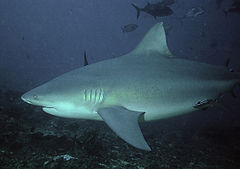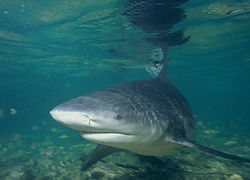
Bull shark
Background to the schools Wikipedia
SOS Children made this Wikipedia selection alongside other schools resources. Before you decide about sponsoring a child, why not learn about different sponsorship charities first?
| Bull shark | |
|---|---|
 |
|
| Conservation status | |
 Near Threatened ( IUCN 3.1) |
|
| Scientific classification | |
| Kingdom: | Animalia |
| Phylum: | Chordate |
| Class: | Chondrichthyes |
| Subclass: | Elasmobranchii |
| Order: | Carcharhiniformes |
| Family: | Carcharhinidae |
| Genus: | Carcharhinus |
| Species: | C. leucas |
| Binomial name | |
| Carcharhinus leucas ( J. P. Müller and Henle, 1839) |
|
 |
|
| Range of bull shark | |
The bull shark, Carcharhinus leucas, also known as the Zambezi shark (UK: Zambesi shark) or unofficially Zambi in Africa and Nicaragua shark in Nicaragua, is a shark commonly found worldwide in warm, shallow waters along coasts and in rivers. The bull shark is known for its aggressive nature, predilection for warm shallow water, and presence in brackish and freshwater systems including estuaries and rivers.
The bull shark can thrive in both saltwater and freshwater and can travel far up rivers. They have even been known to travel as far up as Kentucky in the Ohio River, although there have been few recorded attacks. They are probably responsible for the majority of near-shore shark attacks, including many attacks attributed to other species. Bull sharks are not actually true freshwater sharks, despite their ability to survive in freshwater habitats (unlike the river sharks of the genus Glyphis).
Etymology
The name bull shark comes from the shark's stocky shape, broad, flat snout, and aggressive, unpredictable behaviour. In India, the bull shark may be confused with the Sundarbans or Ganges shark. In Africa, it is also commonly called the Zambezi River shark or just Zambi. Its wide range and diverse habitats result in many other local names, including Ganges River shark, Fitzroy Creek whaler, van Rooyen’s shark, Lake Nicaragua shark, river shark, freshwater whaler, estuary whaler, Swan River whaler, cub shark, and shovelnose shark.
Distribution and habitat
The bull shark is commonly found worldwide in coastal areas of warm oceans, in rivers and lakes, and occasionally salt and freshwater streams if they are deep enough. It is found to a depth of 150 metres (490 ft), but does not usually swim deeper than 30 metres (98 ft). In the Atlantic, it is found from Massachusetts to southern Brazil, and from Morocco to Angola. In the Indian Ocean, it is found from South Africa to Kenya, India, and Vietnam to Australia.
Populations of bull sharks are also found in several major rivers, with more than 500 bull sharks thought to be living in the Brisbane River. One was reportedly seen swimming the flooded streets of Brisbane, Queensland, Australia, during the Queensland floods of late 2010/early 2011. Several were sighted in one of the main streets of Goodna, Queensland, Australia, shortly after the peak of the January, 2011, floods. There are greater numbers still in the canals of the Gold Coast, also in Queensland, Australia. A large bull shark was caught in the canals of Scarborough, two hours north of the Gold Coast. In the Pacific Ocean, it can be found from Baja California to Ecuador. The shark has traveled 4,000 kilometres (2,500 mi) up the Amazon River to Iquitos in Peru. It also lives in fresh water Lake Nicaragua, in the Ganges and Brahmaputra rivers of West Bengal and Assam in eastern India and adjoining Bangladesh. It can live in water with a high salt content as in St. Lucia Estuary in South Africa. The bull shark is generally prolific in the warm coastal waters and estuarine systems of the Mozambique Channel and southward, including Kwa-Zulu Natal and Mozambique. The species has a distinct preference for warm currents.
After Hurricane Katrina, many bull sharks were sighted in Lake Pontchartrain. Bull sharks have occasionally gone up the Mississippi River as far upstream as Alton, Illinois. They have also been found in the Potomac River in Maryland.
Freshwater tolerance
The bull shark is the best known of 43 species of elasmobranch in ten genera and four families to have been reported in fresh water. Other species that enter rivers include the stingrays ( Dasyatidae, Potamotrygonidae and others) and sawfish ( Pristidae). Some skates ( Rajidae), smooth dogfishes ( Triakidae), and sandbar sharks ( Carcharhinus plumbeus) regularly enter estuaries. Elasmobranchs' ability to enter fresh water is limited because their blood is normally at least as salty (in terms of osmotic strength) as seawater through the accumulation of urea and trimethylamine oxide, but bull sharks living in fresh water show a significantly reduced concentration of urea within their blood. Despite this, the solute composition (i.e. osmolarity) of a bull shark in freshwater is still much higher than that of the external environment. This results in a large influx of water across the gills due to osmosis and loss of sodium and chloride from the shark's body. However, bull sharks in freshwater possess several organs with which to maintain appropriate salt and water balance; these are the rectal gland, kidneys, liver and gills. All elasmobranchs have a rectal gland which functions in the excretion of excess salts accumulated as a consequence of living in seawater. Bull sharks in freshwater environments decrease the salt-excretory activity of the rectal gland, thereby conserving sodium and chloride. The kidneys produce large amounts of dilute urine, but also play an important role in the active reabsorption of solutes into the blood. The gills of bull sharks are likely to be involved in the uptake of sodium and chloride from the surrounding freshwater, whereas urea is produced in the liver as required with changes in environmental salinity.
Initially, scientists thought the sharks in Lake Nicaragua belonged to an endemic species, the Lake Nicaragua shark (Carcharhinus nicaraguensis). In 1961, following specimens comparisons, taxonomists synonymized them. They can jump along the rapids of the San Juan River (which connects Lake Nicaragua and the Caribbean Sea), almost like salmon. Bull sharks tagged inside the lake have later been caught in the open ocean (and vice versa), with some taking as little as seven to eleven days to complete the journey.
Anatomy and appearance
Bull sharks are large and stout, with females being larger than males. The bull shark can be up to 81 cm (2.66 ft) in length at birth Adult female bull sharks average 2.4 m (7.9 ft) long and typically weigh 130 kg (290 lb), whereas the slightly smaller adult male averages 2.25 m (7.4 ft) and 95 kg (210 lb). While a maximum size of 3.5 m (11 ft) is commonly reported, there is a questionable record of a female specimen of exactly 4 m (13 ft). The maximum recorded weight of a bull shark was 315 kg (690 lb) but may be larger. Bull sharks are wider and heavier than other requiem sharks of comparable length, and are grey on top and white below. The second dorsal fin is smaller than the first. The bull shark's caudal fin is longer and lower than that of the larger sharks, it also has a small snout, and it lacks an interdorsal ridge.
Bull sharks have a bite force of up to 600 kilograms (1,300 lb), the highest among all investigated cartilaginous fishes.
Diet
A bull shark's diet consists mainly of bony fish and sharks, including other bull sharks, but can also include turtles, birds, dolphins, terrestrial mammals, crustaceans, echinoderms,and stingrays . They hunt in murky waters because it is harder for the prey to see the shark coming. Bull sharks have been known to use the bump-and-bite technique to attack their prey.
Behaviour
Bull sharks are typically solitary hunters, but occasionally hunt in pairs. They often cruise through shallow waters. They can accelerate rapidly and can be highly aggressive, even possibly attacking a racehorse in the Brisbane River in the Australian state of Queensland. They are extremely territorial and attack animals that enter their territory. Since bull sharks often dwell in very shallow waters, they may be more dangerous to humans than any other species of shark, and along with the tiger shark, oceanic whitetip and great white shark, are among the four shark species most likely to attack humans.
One or several bull sharks may have been responsible for the Jersey Shore shark attacks of 1916, which was the inspiration for Peter Benchley's novel Jaws. The speculation of bull sharks possibly being responsible is based on some attacks occurring in brackish and freshwater, as well as there being certain similarities in bite marks between bull and great white sharks.
The bull shark is responsible for attacks around the Sydney Harbour inlets. Most of these attacks were previously attributed to great whites. In India, bull sharks swim up the Ganges River and have attacked people. Many of these attacks have been attributed to the Ganges shark, Glyphis gangeticus, a critically endangered river shark species that is probably the only other shark in India able to survive in fresh water, although the grey nurse shark was also blamed during the sixties and seventies.
Reproduction
Bull sharks mate during late summer and early autumn, often in the brackish water of river mouths. After gestating for 12 months, a bull shark may give birth to four to ten live young. They are viviparous; they are born live and free-swimming. The young are about 70 cm (27.6 in) at birth and take 10 years to reach maturity. Coastal lagoons, river mouths, and other low-salinity estuaries are common nursery habitats.
Ecology
Bull sharks are apex predators and rarely have to fear being attacked by other animals. Humans are their biggest threat. Larger sharks, such as the tiger shark and great white shark, may attack them. There have been stories documented in the media of saltwater crocodiles preying on young bull sharks in the rivers and estuaries of Northern Australia.
In popular culture
In the 2003 movie Red Water, a big bull shark wreaks havoc in a river in Louisiana.


